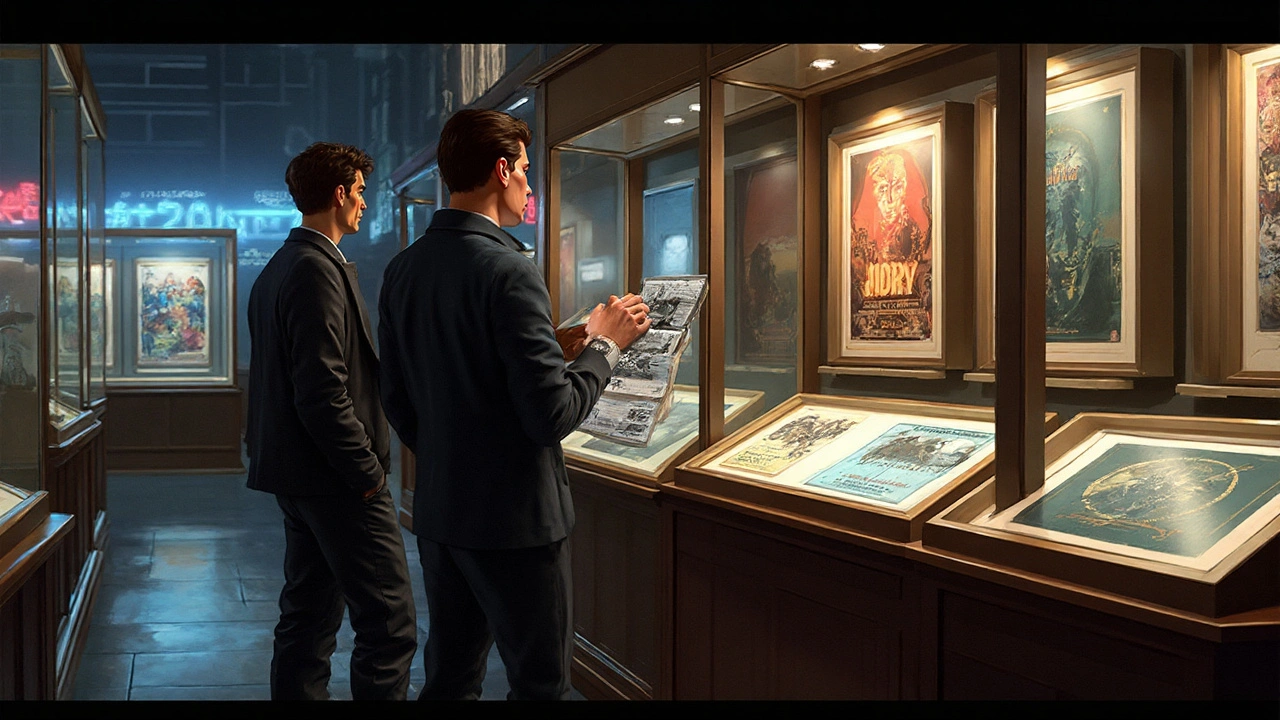Movie Poster Value Estimator
Movie poster is a printed promotional artwork created for a film's release, typically sized 27×40 inches and printed on paper or vinyl.
Rarity refers to how few copies of a particular poster were produced or have survived.
Condition is the state of preservation measured on a grading scale from Mint to Poor.
Provenance denotes the documented ownership history that can verify authenticity.
Artist is the illustrator or designer credited with creating the poster's artwork.
Edition size indicates the total number of prints made for that specific poster version.
Auction house is a trusted marketplace such as Heritage, Bonhams, or Christie's that records final sale prices.
Collector describes an enthusiast who buys, preserves, and trades movie posters as investment pieces.
Quick Checklist for Estimating movie poster value
- Identify the film, release year, and original artwork credit.
- Check the poster’s rarity - limited edition, one‑sheet, or promotional variant?
- Inspect condition - look for tears, creases, fading, or water damage.
- Gather provenance - original purchase receipt, previous auction catalog, or certification.
- Research recent sales of the same title on auction house databases.
- Consider hiring a professional appraiser if the estimated range exceeds $1,000.
Why Rarity Matters More Than Age
Collectors love the thrill of owning something few people have. A poster printed in a run of 5,000 for a blockbuster like Star Wars (1977) is common, whereas a 1979 Apocalypse Now limited‑edition hand‑painted sheet may have only 200 copies. Rarity drives demand, which in turn lifts price. Historical data from auction houses shows a 250% price premium for posters with edition sizes under 500 compared to mass‑produced prints.
Condition Grading: The Key to Accurate Valuation
Condition is the single most transparent metric because it can be standardized. Below is a widely used grading guide:
| Grade | Typical Price Multiplier | Key Characteristics |
|---|---|---|
| Mint (M) | 1.0× | No flaws, original colors, pristine edges |
| Near Mint (NM) | 0.85× | Minor small crease, no discoloration |
| Very Good (VG) | 0.65× | Visible crease or small tear, color shift < 5% |
| Good (G) | 0.45× | Multiple tears, moderate fading, possible repairs |
| Poor (P) | 0.20× | Heavy damage, water stains, missing corners |
When you assign a grade, multiply the baseline market price (derived from rarity and demand) by the appropriate multiplier.
Provenance: The Trust Factor
Even a rare poster can be de‑valued if its origin is unclear. Original studio archives, a signed certificate from the artist, or a documented chain of ownership (e.g., “Purchased at 1981 Sotheby’s sale”) give buyers confidence. Auction results often note “With provenance” and sell for 15‑30% more than comparable items lacking that history.
The Artist’s Signature Impact
Icons like Saul Bass or John Alvin add a premium. Their names can increase a poster’s value by 40‑80% versus a generic design. Look for a visible signature, stamp, or a verified artist’s label on the back of the print.

Edition Size vs. Print Run
Even within a limited edition, variations exist: “First printing”, “Second printing”, or “Reprint”. First‑print runs are prized because they retain the original ink colors and paper quality. A 1994 Pulp Fiction first‑print poster fetches roughly $1,200, whereas a later reprint of the same design sells for $350.
Understanding Market Demand
Demand fluctuates with pop culture trends. When a classic film gets a new streaming release or a sequel, interest spikes. Monitoring sites like Heritage Auctions, eBay sold listings, and the PosterArt price guide (annual report) can reveal these patterns. For example, after the 2023 release of the Barbie movie, vintage Barbie 1960s promotional posters jumped 120% in price.
Where to Research Prices
- Auction house archives: Search past sales by title, year, and grade.
- Price guide publications: Movie Poster Price Guide (2024 edition) lists median values for 10,000+ items.
- Online marketplaces: Look at completed eBay listings, not just asking prices.
- Collector forums: Communities like PosterCollectors.org share recent transaction data.
Compile at least three data points before forming a valuation.
When to Sell - Timing Your Exit
Ideal timing aligns with two factors: heightened public interest and a strong market for comparable sales. If your poster’s genre (e.g., horror) is getting a major anniversary edition, list within a 6‑month window surrounding the event. Conversely, avoid listing during market dips such as post‑award‑season slowdowns.
Professional Appraisal: When and How
Consider a professional appraisal if:
- Your estimated value exceeds $2,000.
- You need an insurance valuation for a home or business policy.
- You plan to sell through a high‑end auction house that requires certified appraisals.
Appraisers typically charge 1‑2% of the assessed value. Ensure they’re accredited by the International Society of Appraisers (ISA) or the Appraisers Association of America (AAA). They’ll provide a written report that includes all the entities we discussed-rarity, condition grade, provenance, artist, and edition size-plus a market‑adjusted price recommendation.
Common Pitfalls to Avoid
- Over‑relying on online price estimates without adjusting for condition.
- Ignoring provenance which can drop a price by up to 30%.
- Cleaning or repairing a poster yourself; improper methods can permanently damage the paper.
- Neglecting edition nuances; a “limited edition” label alone isn’t enough-verify the exact print number.
By staying systematic-identifying each entity, grading condition, and cross‑checking market data-you’ll know with confidence whether your movie poster holds monetary value.

Frequently Asked Questions
How can I tell if my poster is a first printing?
First printings usually have the original studio’s logo, no barcode, and may include a signed artist’s mark. Compare your piece to reference images in the Movie Poster Price Guide or contact the studio archives for verification.
What grading scale should I use for condition?
The most accepted scale runs from Mint (M) to Poor (P). Use the table above as a reference and, if possible, have a certified appraiser assign a grade for high‑value items.
Do I need a certificate of authenticity?
A certificate from the original studio, artist, or a recognized authentication service (e.g., PSA/DNA) adds credibility and can raise the sale price by 15‑25%.
Where should I store my poster to keep it in top condition?
Store flat in a climate‑controlled environment (68‑72°F, 40‑50% RH). Use acid‑free sleeves and avoid direct sunlight. Consider a archival‑grade framing with UV‑blocking glass.
How often do auction prices fluctuate?
Prices can shift 10‑30% year‑to‑year depending on trends, re‑releases, and collector sentiment. Tracking quarterly auction results gives the clearest picture.


